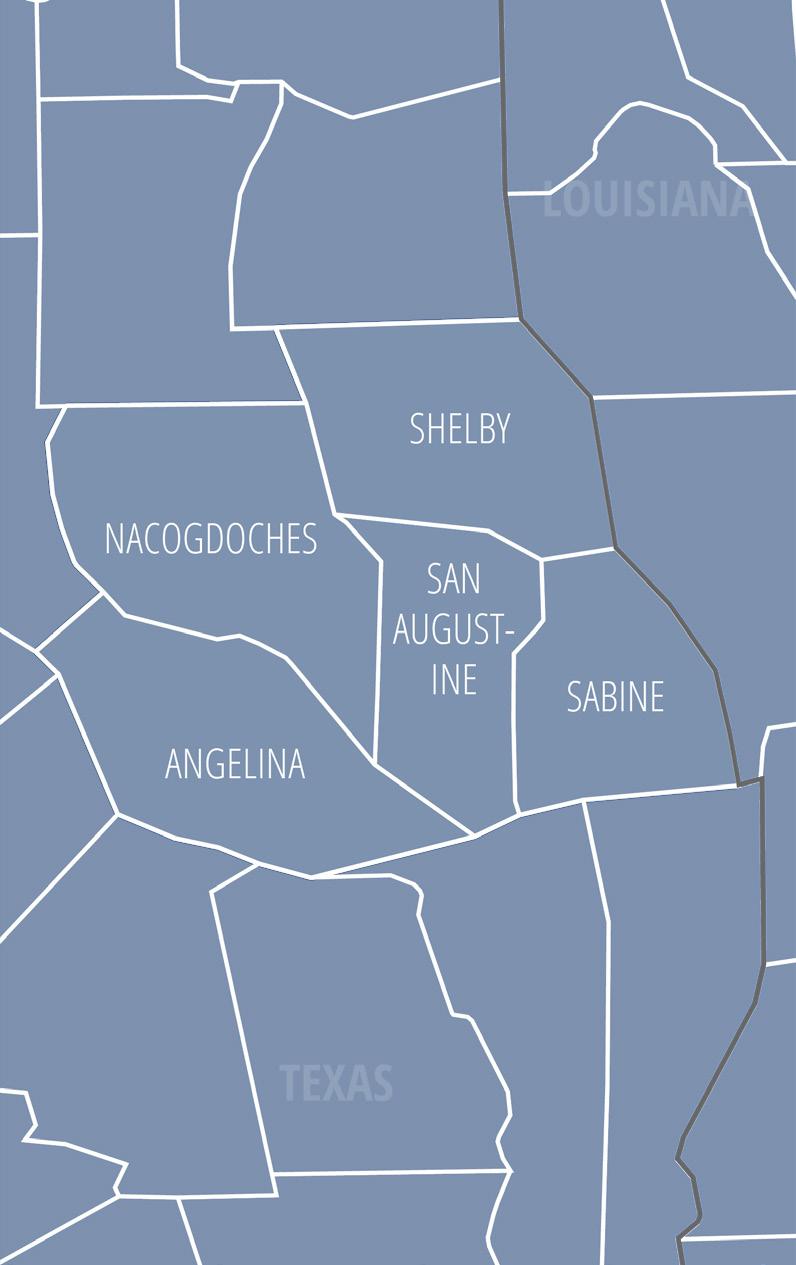
6 minute read
EXECUTIVE SUMMARY
T.L.L. Temple Foundation’s
ACKNOWLEDGMENTS
This Lufkin-Nacogdoches Region Economic and Labor Market Profile is part of a series commissioned by the T.L.L. Temple Foundation, which includes the following reports: 1. Rural East Texas Economic Opportunity
Analysis Summary Profile, 2. Beaumont-Port Arthur Region Economic and Labor Market Profile, 3. Lufkin-Nacogdoches Region Economic and Labor Market Profile, and 4. Texarkana Region Economic and Labor Market Profile. The four profiles have also been collected into a comprehensive edition, titled “Rural East Texas Economic Opportunity Analysis.”
The goals of this work are to strengthen the alignment of and linkages between the talent pipeline and key industry clusters in rural East Texas. Economic and labor market research was provided by Alexander Research and Consulting. Graphic design was completed by Safflor Design.
All profiles are available for download from the T.L.L. Temple Foundation’s website at www.tlltemple.foundation.
ABOUT THE PROJECT SPONSORS AND CONSULTING TEAM
The T.L.L. Temple Foundation works alongside rural communities to build a thriving East Texas and to alleviate poverty, creating access and opportunities for all.


Sylvia Leal
Jerry Kenney
Alexander Research & Consulting provides insights and support to help organizations amplify their impact. I offer a wide range services - research, analytics, program evaluation, strategic planning, and implementation support – with a specialization in community, economic, and workforce development.
Caroline Alexander
Principal caroline@alexanderrc.com
Non-credited images used in this report were licensed from Adobe Stock. Cover image and other Boggy Slough Nature Preserve images used with permission from Jay Brittain. All other images sourced as attributed.
CONTENTS
EXECUTIVE SUMMARY . . . . . . . . . . . . . . . . . . . . . . . . . . . . . . . . . . . . . . . . . . . . . . . . . . . . . . . . . . . . . . . . . . . 1 Lufkin-Nacogdoches Region Summary .......................................................... 2 LUFKIN-NACOGDOCHES REGION ECONOMY . . . . . . . . . . . . . . . . . . . . . . . . . . . . . . . . . . . . . . . . . . . . . . . . 5 Summary of Findings ......................................................................... 6 Data Analysis ............................................................................... 7 LUFKIN-NACOGDOCHES REGION LABOR MARKET CHARACTERISTICS . . . . . . . . . . . . . . . . . . . . . . . . 13 Summary of Findings ........................................................................ 14 Data Analysis .............................................................................. 15 LUFKIN-NACOGDOCHES REGION WORKFORCE DEMAND . . . . . . . . . . . . . . . . . . . . . . . . . . . . . . . . . . . 19 Summary of Findings ........................................................................ 20 Data Analysis .............................................................................. 22 LUFKIN-NACOGDOCHES REGION EDUCATION AND TRAINING INFRASTRUCTURE . . . . . . . . . . . . . . . 35 Summary of Findings ........................................................................ 36 Data Analysis .............................................................................. 37 KEY CONCEPTS . . . . . . . . . . . . . . . . . . . . . . . . . . . . . . . . . . . . . . . . . . . . . . . . . . . . . . . . . . . . . . . . . . . . . . . 45 Definition Of Terms ......................................................................... 46
EXECUTIVE SUMMARY

LUFKIN-NACOGDOCHES REGION SUMMARY

KEY FINDINGS
The Situation
Though the Lufkin-Nacogdoches region had never fully recovered from the Great Recession, it had been growing, slowly but surely, in most of the years leading up to the Pandemic. With pronounced industry clusters related to forestry and forest products and livestock production and processing, the economy has shown a degree of stability and resiliency in spite of mild population loss in the region. Although these clusters are resource-based, the presence of downstream pieces of the value chain means greater job and wealth creation opportunities overall. These clusters will likely face ongoing modernization and automation pressures; however, their demand outlook is favorable. On the other hand, declining population poses a risk as it can lead to job losses in sectors that rely on population, including retail trade; healthcare; other services; and government.
Economic Drivers
In addition to forestry and forest products and livestock production and processing, the LufkinNacogdoches region has a large healthcare sector as well as a cluster of activities that center on and around Stephen F. Austin State University. These specializations are reflected in the region’s industry and occupational strengths.
Workforce Demand
Middle-skill and middle-wage occupations occupy the largest share of the regional employment base. However, these jobs have been declining and are expected to experience only modest growth in the coming years. On the other hand, the share of high skill is trending upward. Though office and administrative occupations are on a downward trend, other occupational families are growing. In fact, a wide range of occupations in business and financial operations; management; healthcare; education; and skilled trades/production are expected to be in highdemand and face less automation risk.
Educational Infrastructure and Alignment
The region has more than 20 school districts and 2 public higher education institutions. Of the almost 2,400 high school graduates from regional school districts that can be tracked, 68 percent are employed in Texas in the fall semester after graduation and about 60 percent of these recent graduates are employed in retail or accommodations and food services. The top destinations for the 61 percent of regional high school graduates that enroll in higher education are Angelina College followed by Stephen F. Austin. In other words, many high school graduates stay local and either work, go to college, or both. Stephen F. Austin is the largest source of bachelor’s degrees and Angelina College serves as an important source of associate’s degrees and certificates. These two institutions together graduate more than enough students to fill entry-level openings that require postsecondary degrees. However, Stephen F. Austin attracts students from around the state and many of their graduates are likely to move to a different region upon graduation. With only Angelina College completions, the region appears to have a shortage of talent, particularly in health science, education and training, and business.
COUNTIES

KEY STATISTICS
195,972
Population (2019)
-0.7%
Population Change (2014-2019)
78,545
Jobs (2020)
46,930
Openings (2021-2026)
EMPLOYMENT BY INDUSTRY
Healthcare Education Retail Trade Manufacturing Accommodation & Food Services Government Construction Other Services (except Public Admin.) Administrative & Support Services Finance & Insurance Wholesale Trade Agriculture, Forestry, Fishing & Hunting Transportation & Warehousing Professional, Scientific, & Tech. Services Mining, Quarrying, & Oil & Gas Extraction Real Estate & Rental & Leasing Information Arts, Entertainment, & Recreation Mgmt. of Companies & Enterprises Utilities 12,237 10,368 9,177 8,342
TOP HIGH-DEMAND, HIGH-WAGE JOBS*
OCCUPATION
1. Heavy & Tractor-Trailer Truck Drivers 2. General & Operations Managers 3. First-Line Supervisors of Retail Sales Workers 4. Bookkeeping, Accounting, & Auditing Clerks 5. First-Line Supervisors of Food Preparation & Serving Workers 6. Registered Nurses 7. Maintenance & Repair Workers, General 8. First-Line Supervisors of Office & Administrative Support Workers 9. Elementary School Teachers, Except Special Education 10. Postsecondary Teachers 11. Correctional Officers & Jailers 12. Licensed Practical & Licensed Vocational Nurses 13. Logging Equipment Operators 14. First-Line Supervisors of Production & Operating Workers 15. Sales Reps., Wholesale & Mfg., Except Tech. & Scientific Products
Source: Emsi 2021.2 – QCEW Employees, Non-QCEW Employees, and Self-Employed. Page 2 header image by Jay Brittain. * Includes only occupations that pay more than $15.00 an hour and require some kind of postsecondary education.



